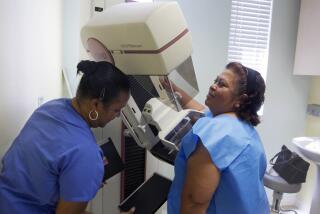Keep Breast in Early Cancer Cases, Panel Advises : Health: A federal committee says it is unable to explain resistance to procedures that don’t involve mastectomy.
- Share via
WASHINGTON — A federal advisory panel, noting that most women in this country with early breast cancer are still undergoing traditional mastectomies, said Thursday that surgery in which the breast is not removed, followed by radiation, is “preferable” in a majority of cases.
Despite substantial evidence in recent years that there is no difference in survival rates between the two procedures, lumpectomy--the removal of the tumor alone--followed by radiation is being used only with “a minority of patients,” said the committee of cancer experts convened by the National Institutes of Health to recommend the best therapy for early breast cancer.
Breast cancer is the most common malignancy among women in the United States and is the second leading cause of cancer death, after lung cancer, among women. Breast cancer will afflict one of every 10 women alive today.
An estimated 150,000 new cases will be diagnosed this year, of which 75% to 80% will be considered in the early stages as defined by tumor size and other factors. In about two-thirds of the early cases, the cancer will not yet have spread to the adjacent underarm lymph nodes.
In advocating breast-saving surgery, however, the National Institutes of Health panel did not make an equally strong endorsement of the use of chemotherapy or hormone therapy after initial surgery and radiation in patients with early breast cancer that has not spread to the lymph nodes.
Recent studies have indicated that such so-called adjuvant therapy decreases the likelihood of a tumor recurrence. Two years ago, the National Cancer Institute issued a controversial “clinical alert” stating that many women with early node-negative breast cancer could benefit from such treatment.
Since that time, the issue has been the subject of intense debate among many breast cancer experts, who have said that they are not convinced that such therapy is the best approach for those women and called for further studies. Most have agreed, though, that it is an effective treatment for women whose cancer has spread to the lymph nodes.
The National Institutes of Health panel said that a majority of these patients “are cured by breast-conserving treatment or total mastectomy.” The panel noted, however, that the rate of cancer recurrence “is decreased” by the use of chemotherapy or the hormonal drug tamoxifen after initial treatment.
Members of the panel said that they were unable to explain the widespread resistance in the United States to procedures that emphasize preserving the breast.
“I’m unhappy assigning fault,” said Dr. William C. Wood, associate professor of surgery at Harvard University Medical School and chief of surgical oncology at the Massachusetts General Hospital Cancer Center, who served as panel chairman.
Speaking at a press conference, Wood acknowledged that many physicians probably still believe that removing the breast “is safer in terms of survival,” despite data to the contrary. Further, he said, some women may be reluctant to undergo six weeks of radiation, which has some side effects.
There is some risk of tumor recurrence among women who have undergone the breast-conserving surgery, although this can be treated surgically by what is known as “salvage mastectomy,” with no overall change in survival rates, the panel said.
Wood said that the panel members were “quite comfortable” that there is no risk for women who opt for the less radical lumpectomy.
“We believe it is preferable to preserve an organ rather than remove it,” he said.
But Dr. I. Craig Henderson, director of the Breast Evaluation Center at the Dana-Farber Cancer Institute in Boston, said that he thought the panel “may have gone a little too far” in calling the less radical treatment “preferable.”
Henderson, who was not a member of the committee, said that he generally favors the procedure but believes that it is “not fair to put women in boxes.” Deciding which procedure to use is “a complicated issue” involving numerous factors, he said.
“Women should judge a lot by what their heart tells them,” he said in a telephone interview. “A doctor can’t just say: ‘This is what I’d want my wife to have.’ ”
Dr. Robert McKenna, a surgical oncologist in private practice in Los Angeles and a past president of the American Cancer Society, said he believed that the panel was wrong in concluding that the less radical procedure is not widely used in this country.
“I think it varies greatly, depending on the city and the training of the physician,” he said in a telephone interview.
“There are pros and cons to both,” he said. “I think a woman has a choice to do one or the other, but I don’t think you should say that absolutely down the line they will be equal.”
He said he found it “alarming . . . that we’re starting to see more recurrences” of cancer after lumpectomy and radiation treatment.
Some patients with early breast cancer are not candidates for breast-saving surgery, the panel said. They include women whose tumors do not have clearly defined margins but show up in multiple areas in the breast.
Also, it is not recommended for women for whom the treatment “would produce an unacceptable cosmetic result,” such as women “whose tumors are large relative to breast size.”
On the issue of whether to employ chemotherapy or hormone therapy among women whose cancer has not spread to the lymph nodes, the panel said that the decision “should follow a thorough discussion” between physician and patient about the risks of relapse, the toxicity of the drugs and the “impact on quality of life.”
The panel said that “the many unanswered questions” regarding adjuvant therapy “make it imperative that all patients who are candidates for clinical trials be offered the opportunity to participate.”






